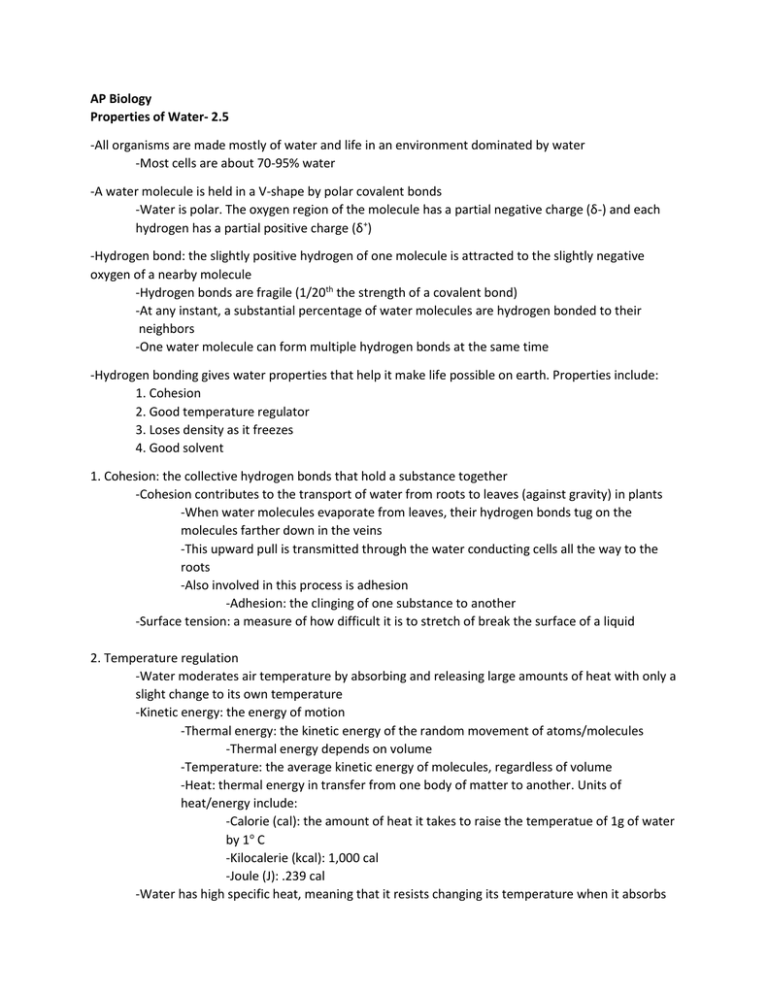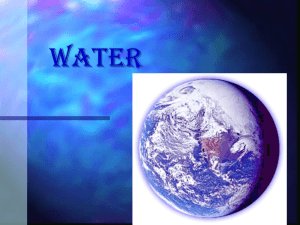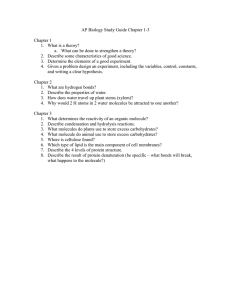Notes- Properties of Water
advertisement

AP Biology Properties of Water- 2.5 -All organisms are made mostly of water and life in an environment dominated by water -Most cells are about 70-95% water -A water molecule is held in a V-shape by polar covalent bonds -Water is polar. The oxygen region of the molecule has a partial negative charge (δ-) and each hydrogen has a partial positive charge (δ+) -Hydrogen bond: the slightly positive hydrogen of one molecule is attracted to the slightly negative oxygen of a nearby molecule -Hydrogen bonds are fragile (1/20th the strength of a covalent bond) -At any instant, a substantial percentage of water molecules are hydrogen bonded to their neighbors -One water molecule can form multiple hydrogen bonds at the same time -Hydrogen bonding gives water properties that help it make life possible on earth. Properties include: 1. Cohesion 2. Good temperature regulator 3. Loses density as it freezes 4. Good solvent 1. Cohesion: the collective hydrogen bonds that hold a substance together -Cohesion contributes to the transport of water from roots to leaves (against gravity) in plants -When water molecules evaporate from leaves, their hydrogen bonds tug on the molecules farther down in the veins -This upward pull is transmitted through the water conducting cells all the way to the roots -Also involved in this process is adhesion -Adhesion: the clinging of one substance to another -Surface tension: a measure of how difficult it is to stretch of break the surface of a liquid 2. Temperature regulation -Water moderates air temperature by absorbing and releasing large amounts of heat with only a slight change to its own temperature -Kinetic energy: the energy of motion -Thermal energy: the kinetic energy of the random movement of atoms/molecules -Thermal energy depends on volume -Temperature: the average kinetic energy of molecules, regardless of volume -Heat: thermal energy in transfer from one body of matter to another. Units of heat/energy include: -Calorie (cal): the amount of heat it takes to raise the temperatue of 1g of water by 1o C -Kilocalerie (kcal): 1,000 cal -Joule (J): .239 cal -Water has high specific heat, meaning that it resists changing its temperature when it absorbs or loses heat. This gives water the ability to stabilize temperature. -Specific heat: the amount of heat that must be absorbed or lost for 1g of that substance to change its temperature by 1o C -Specific heat is due to H-bonding. Energy is required to break H-bonds, so, as a body of water gains heat energy, most of it has to be used to break H-bonds first before it can be used to increase the movement of the water molecules and increase temperature. -Water’s high specific heat gives it the ability to regulate temperature in an ecosystem, stabilize ocean temperatures, and protect living cells from extreme changes in temperature -Evaporative cooling: as liquid evaporates, the surface of the liquid left behind is cooled -Evaporation: when molecules move fast enough to overcome the bonds holding them together and enter the air as a gas (liquid gas) -Evaporation occurs at any temperature but increases as temperature increases -Heat of vaporization: the quantity of heat a liquid must absorb for 1g of it to be converted from liquid to gas -Water has a high heat of vaporization- a lot of heat must be absorbed for water to be vaporized -Due to the hydrogen bonds that must be broken -Water’s high heat of vaporization makes it a good regulator of earth’s climate. It’s also what causes steam burns to be so severe compared to that of boiling water- steam contains so much more heat energy. 3. Water loses density as it freezes -While other materials contract and become more dense when they solidify, water expands due because the hydrogen bonds keep water molecules a certain distance apart in the solid state -This causes ice to be about 10% less dense than liquid water -This property of water protects aquatic environments from completely freezing over in the winter, allowing life to exist below the surface ice 4. Water is a good solvent -Solution: a liquid that is a completely homogenous mixture of two or more substances -Solvent: the dissolving agent in a solution; whatever there’s “more of” -Solute: the substance that is dissolved into a solution; whatever there’s “less of” -Aqueous solution: water is the solvent -Water is a versatile solvent because of its polar nature -Water dissolves substances by forming hydration shells around molecules based on their charges -Hydration shell: the sphere of water molecules around each dissolved ion -A substance must be hydrophilic to be water-soluble -Hydrophilic: has an affinity for water Ex. Ions, polar molecules, any molecule with ionic or polar regions on its surface -Hydrophobic: substances that repel water Ex. Nonionic, nonpolar, or otherwise cannot form H-bonds -Calculating solute concentration in aqueous solutions -Molecular mass: the sum of the masses of all the atoms in a molecule -Mole (mol): the number of grams of a substance that equals its molecular weight in daltons and contains Avogadro’s number of molecules -A mole of one substance has exactly the same number of molecules as a mole of any other substance -Molarity: the number of moles of solute per liter of solution -A 1M solution of sucrose= molecular mass of sucrose (342 daltons) = 342g sucrose + enough water to bring the total volume to 1L









